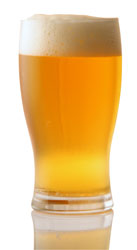Since I got back into brewing two years ago, I've had a problem with chill haze. Now, ultimately, I'm going to fix the process problem that's causing it, but that doesn't help for the beer I've already brewed. I've been thinking about adding gelatin to clear up the chill haze a bit. Out of curiousity, I decided to run an experiment. I pulled two growlers of my MLPA, mixed one up with the recommended dose of gelatin, and left the other as is. I'm going to monitor it daily to see how fast and how well the gelatin beer clears up compared to the control. Then, of course, is the fun part...taste test. :scratch:Here are the results for Day 0.1.) Control growler with light directly behind

2.) Gelatin growler with light directly behind:

3.) Control growler with light at 45° angle:

4.) Gelatin growler with light at 45° angle:

The growlers with the light at 45° look a little different, that's just because I didn't get them at exactly the same angle. I'll update with new pictures daily.
 2.) Gelatin growler with light directly behind:
2.) Gelatin growler with light directly behind: 3.) Control growler with light at 45° angle:
3.) Control growler with light at 45° angle: 4.) Gelatin growler with light at 45° angle:
4.) Gelatin growler with light at 45° angle: The growlers with the light at 45° look a little different, that's just because I didn't get them at exactly the same angle. I'll update with new pictures daily.
The growlers with the light at 45° look a little different, that's just because I didn't get them at exactly the same angle. I'll update with new pictures daily.





















